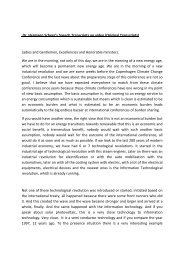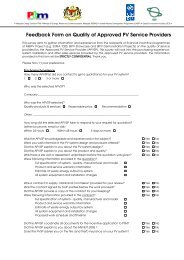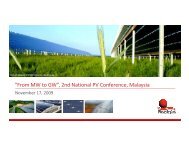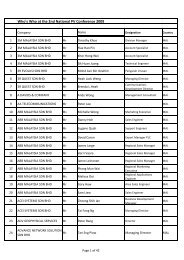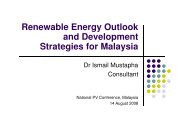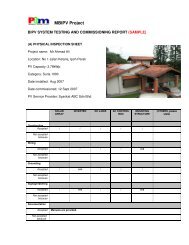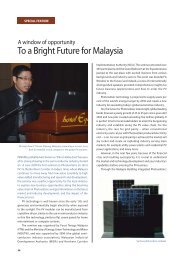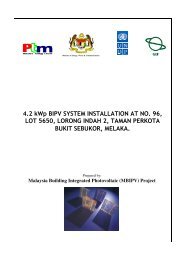MBIPV Project Brief
MBIPV Project Brief
MBIPV Project Brief
Create successful ePaper yourself
Turn your PDF publications into a flip-book with our unique Google optimized e-Paper software.
kWP amorphous silicon PV module, and 1.1 kWp polycrystalline module) integrated into 3different types of roofs.43. Unfortunately, these initiatives are all “one-off” projects and are not leading to a sustainableBIPV market. With the proposed GEF supported project on BIPV, Malaysia would be able tofurther demonstrate BIPV technology that would significantly complement the energy efficiencyinitiative. It is vital that the proposed BIPV project components would pave the way towardslong-term cost reduction of BIPV technology. Thus, the total Government efforts to promote andaccelerate renewable energy and energy efficiency developments in Malaysia would becomemore successful. Furthermore, this new BIPV project will make use potential synergies with theother GEF supported projects currently under implementation, i.e. the Malaysia Industrial EnergyEfficiency Improvement <strong>Project</strong> (MIEEIP), and the Biomass-based Power Generation and Cogenerationin the Malaysian Palm Oil Industry <strong>Project</strong> (Biogen).BASELINE AND ALTERNATIVE SCENARIOS44. The South East Asian region is one of the fastest growing regions in the world with significantdemand for electricity. The current maximum electricity demand in Malaysia is about 10,000MW and is projected to grow by about 6% to 8% annually. To meet this demand, Malaysia willcontinue to install new conventional power plants. Coal fired power plants are very popular dueto the price and potential shortage of fuel and natural gas supply. In immediate future, the coalenergy mix for power generation in Malaysia will be more than doubled. To mitigate theenvironmental pollution caused by the increase share of coal in the country’s energy mix,renewable energy is being promoted. In Malaysia, biomass is currently being favored as REresource due to its availability. BIPV would unfortunately be left out as an RE alternative sinceits cost is still very expensive, and it would remain as an "exotic" technology. The results of thepilot grid-connected PV project that were implemented between 1998 and 2002 manifested thoseperceptions. Although the total system cost has gone down by 60% within that period, the capitalrequirement BIPV systems are still very expensive at US$7,200 per kWp 4 . Hence the paybackperiod would be more than sixty years under the current Malaysian scenario. Thus, the high costof BIPV technology is the main obstacle itself. Thereby, BIPV technology could never bedeveloped into a commercially viable RE technology in Malaysia, even though the BIPVperformance is better that those systems installed in Germany and Japan.45. Under a baseline scenario, some efforts on BIPV will continue through private initiatives andsome activities of the MECM, PTM, CETREE and SIRIM such as information and educationcampaigns, and development of standards. Upcoming activities under the baseline scenario focuson two R&D projects targeting local manufacturing of BIPV components and marketenhancement activities, such as demonstration of BIPV in government buildings and a gridconnectedPV program. A testing facility on safety for inverter products will be established atSIRIM and will provide valuable experiences and feedback for the R&D sector. But, as in thepast, these activities will be promoted in a fragmented manner and it is up to the public and theprivate sector to spur the technology towards widespread and cost-attractive applications.46. This proposed GEF supported alternative will enable the widespread use of BIPV systems andthus, cost reduction of the technology. The successful implementation of identified and designedinterventions packaged into 4 project components will establish a suitable environment for a4 Ibid.14



